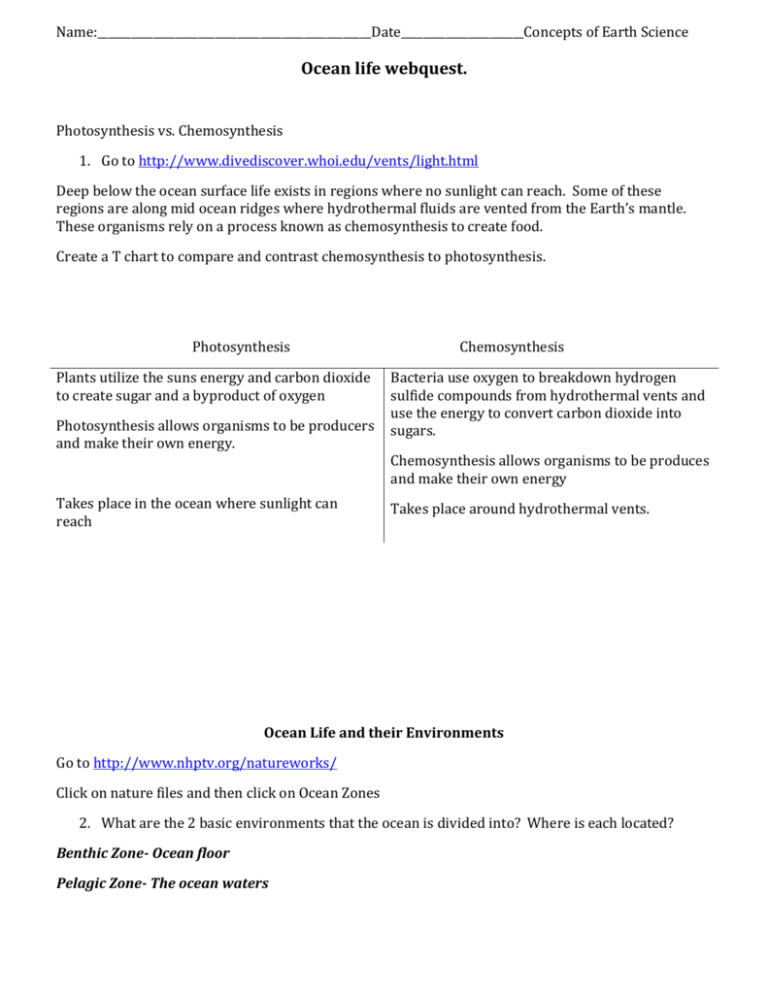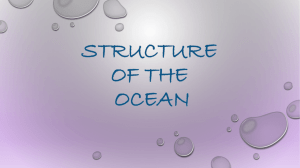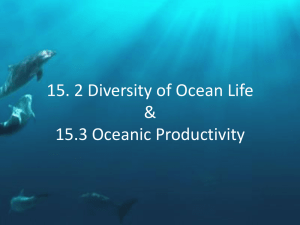Ocean life webquest. Photosynthesis vs. Chemosynthesis Go to http
advertisement

Name:_________________________________________________Date______________________Concepts of Earth Science Ocean life webquest. Photosynthesis vs. Chemosynthesis 1. Go to http://www.divediscover.whoi.edu/vents/light.html Deep below the ocean surface life exists in regions where no sunlight can reach. Some of these regions are along mid ocean ridges where hydrothermal fluids are vented from the Earth’s mantle. These organisms rely on a process known as chemosynthesis to create food. Create a T chart to compare and contrast chemosynthesis to photosynthesis. Photosynthesis Plants utilize the suns energy and carbon dioxide to create sugar and a byproduct of oxygen Photosynthesis allows organisms to be producers and make their own energy. Takes place in the ocean where sunlight can reach Chemosynthesis Bacteria use oxygen to breakdown hydrogen sulfide compounds from hydrothermal vents and use the energy to convert carbon dioxide into sugars. Chemosynthesis allows organisms to be produces and make their own energy Takes place around hydrothermal vents. Ocean Life and their Environments Go to http://www.nhptv.org/natureworks/ Click on nature files and then click on Ocean Zones 2. What are the 2 basic environments that the ocean is divided into? Where is each located? Benthic Zone- Ocean floor Pelagic Zone- The ocean waters 3. Briefly describe the three zones and their depths that the pelagic region is divided into. Sunlit zone-this is the ocean zone that sunlight penetrates up to 660 feet Twilight zone-some sunlight reaches this zone, but not enough for photosynthesis to occur. This zone goes down to about 3,300 feet Midnight zone. No sunlight reaches this zone and it can reach depths of close to 20,000 feet 4. There is life that can survive deep in the twilight zone, what are some adaptations of the organisms in this zone that help them to survive? Thin bodies Red or Black in color Sharp fangs or teeth Large eyes Bioluminescence 5. Go back to the nature files and click on Plankton. Where does the word plankton come from and what does it mean? Plankton is the foundation of the ocean food web. The word plankton comes from the Greek word "planktos" which means drifting. 6. Which type of plankton makes up 30% of the ocean floor? What else is made of this plankton? Foraminifera which are tiny single-celled, shell-covered organisms, that are usually between a millimeter and a centimeter in diameter. Foraminifera make up chalk and limestone 7. Jelly fish are basically what? How do they catch and eat food? Jelly fish are basically large stomachs and tentacles. Their tentacles have stingers on them and they use them to catch and paralyze food and carry it to their stomachs 8. Are Siphonophores actually jellyfish? Explain No, they are really groups or colonies of animals. Each organism in the colony has a special niche or role. Go back to the nature files and click on nekton 9. What are nekton? What are the 3 main groups of nekton? Give an example of each. Nekton are all the organisms that swim in the ocean freely. chordates -bony fish, whales, sharks, turtles, snakes, eels, porpoises, dolphins and seals. Molluscan nekton are animals like octopus and squid. Arthropod nekton are animals like shrimp. 10. Click on the squid/octopus link. What are 2 ways that a squid is different than an octopus? An octopus has no shell while a squid has a shell in its body called a pen Squid have 10 arms (2 are longer tentacles) An octopus has 8 tentacles Squid live in groups and octopi live alone Go back to the nature files and click on benthos. 11. What does benthos mean? What are some examples of benthos? The benthos live on the ocean floor. Starfish, oysters, clams, sea cucumbers, brittlestars and anemone are all benthos 12. How is life in the benthos organized? Life in the benthos region is organized by size 13. Is seaweed a plant? Explain. What does this organism do for the Earth? Seaweeds aren't plants. They are algae. Algae are protists Algae provide much of the Earth's oxygen 14. Is a starfish a fish? Explain. What are some ways that starfish eat? Starfish aren't fish. They are invertebrates. They have no bones.








